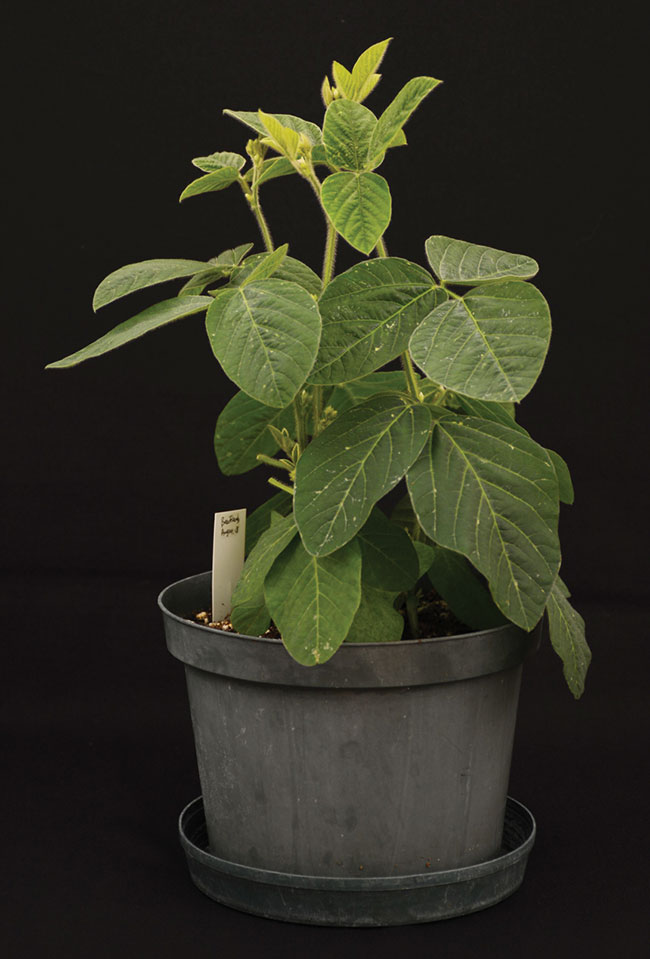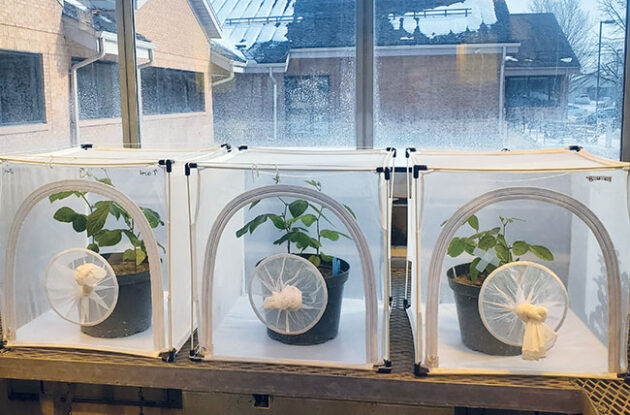
Features
Insect Pests
Soybeans
Getting to the roots of resistance
Are soybean aphids drawn to more nutritious soybean leaves?
May 9, 2023 By Julienne Isaacs
 Researchers looked at isoflavonoids concentrations in soybean plant leaves to see if cultivars could be bred with improved resistance.
Photos courtesy of Sangeeta Dhaubhadel.
Researchers looked at isoflavonoids concentrations in soybean plant leaves to see if cultivars could be bred with improved resistance.
Photos courtesy of Sangeeta Dhaubhadel. Soybean aphid is a perennial problem in Ontario fields. The pest can reach economic threshold levels in dry years, when already stressed soybean plants are vulnerable to insect pest pressure. 2021 was one such year.
The weather is not in producers’ control. But the genetics they choose can make a big difference.
Some cultivars are more resistant than others, and two Agriculture and Agri-Food Canada (AAFC) researchers aim to know why.
Sangeeta Dhaubhadel and Ian Scott, both research scientists at AAFC’s London Research and Development Centre, co-led a study looking at metabolic resistance to soybean aphid feeding in soybean cultivars that was published in the journal Insects last year.
Dhaubhadel’s research in part looks at identifying factors that supply resistance against pests and pathogens; Scott, an entomologist, focuses on insect-plant interactions and host plant resistance.
In this study, they set out to look at the concentrations of isoflavonoids and other metabolites in the leaves of the soybean plants – resistant and susceptible – in order to help breeders zero in on particular cultivars that could be used to breed soybeans with improved resistance.
“Leaf metabolites are natural chemical compounds present in a plant, in the leaves,” explains Dhaubhadel. “Isoflavonoids are natural compounds with many biological roles, including protecting plants from pathogens. The type and amount of these varies, depending on genetic and environmental factors and the stresses [plants are] exposed to.”
Isoflavonoids can have a negative effect on insects – they act as a feeding deterrent.
Chinese research has found that isoflavonoids do supply resistance against aphids to soybean plants, she adds. But the research had to be confirmed with Canadian cultivars.
Research results
As a first step, Dhaubhadel and Scott did a survey of 18 commonly grown cultivars in Ontario. They then measuredisoflavonoid levels in each of the 18 lines, at the V1 and V3 growth stages. The cultivars were classified as having high, moderate and low levels of isoflavonoids.
But the results did not show a straightforward link between high levels of isoflavonoids and improved resistance.
“What we observed when we compared the isoflavonoid leaf levels with resistance to aphids across those 18 soybean varieties was that the isoflavonoids that we measured weren’t really providing us with a good biomarker for the aphid resistance. They weren’t explaining why certain varieties were more or less susceptible,” says Scott. “It wasn’t always a strong relationship.”
So, the researchers looked for relationships between other metabolites in the leaves and resistance to soybean aphid. They found a difference between levels of free amino acids in the leaves of the different cultivars, and there were lower levels of free amino acids in some of the most resistant varieties.
“This provided evidence that the nutrition of the plants was leading to the difference in aphid numbers. Higher leaf levels of specific free amino acids has been shown to lead to improved nutrition for aphids, which allowed for increased growth of the aphids and higher numbers,” explains Scott.
Does this mean that aphids are drawn to feed on plants that have an improved nutritional profile? Scott says that’s a hard question to answer – and to prove. But, he says, “Other researchers have found that there are links between the nutritional quality of the plants and the success of the insects on those plants in terms of their growth and survival.”

Aphids were hand-placed on the plants studied in the lab, so it’s difficult to make conclusive statements about how aphids would act in a field setting.
Which cultivars?
The experiment was done in a lab, and aphids were hand-placed on the plants that Scott and Dhaubhadel studied. That means it’s difficult to make conclusive statements about whether aphids would choose to feed on the same cultivars in a field setting.
More testing is needed, says Scott.
But two frontrunners did emerge from the group of 18 cultivars in terms of their resistance to soybean aphid: Harosoy 63 and OAC Avatar. Conversely, the cultivar Maple Arrow fared the worst of the group in terms of susceptibility. Pagoda and Conrad both showed more tolerance to aphid feeding damage.
Harosoy 63 is used mainly in lab settings as a control, says Dhaubhadel – it isn’t commonly planted. But OAC Avatar, a relatively new variety developed by University of Guelph research scientist Istvan Rajcan, is a top-yielding variety that is still grown in Ontario.
Dhaubhadel and Scott don’t currently have funding to continue the experiment with field tests. But their hope is that their groundwork can be used by soybean breeders to develop new cultivars with improved resistance. Improved genetics could mean a reduced need for insecticide applications and an improved environment for beneficial insects, like lady beetles, to control the pest naturally.